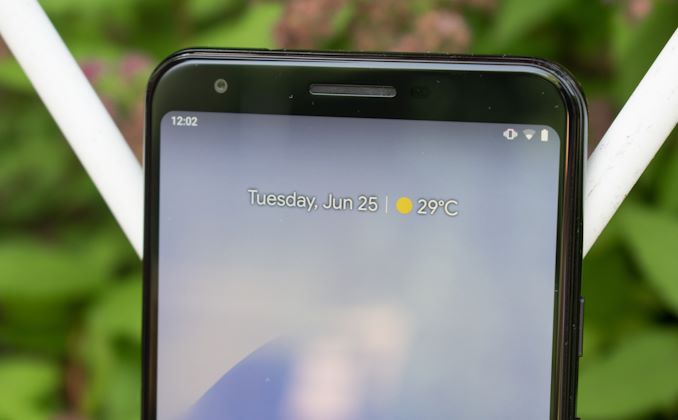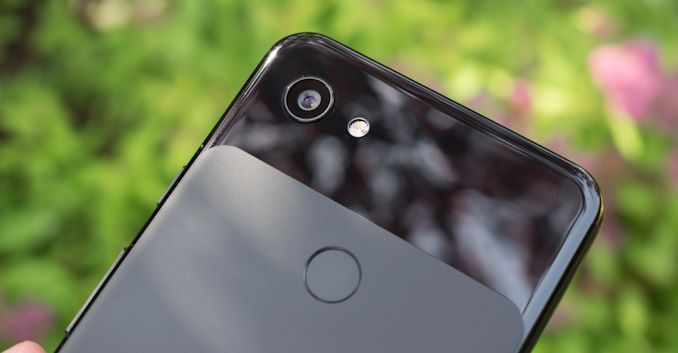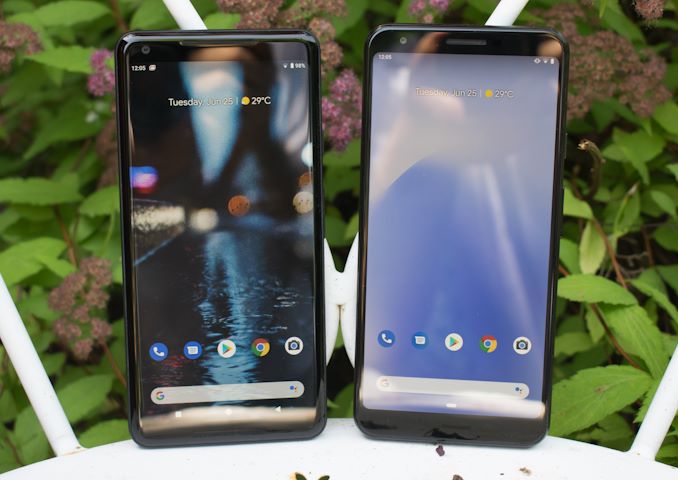The Google Pixel 3a XL Review: Does Mid-Range Make Sense?
by Andrei Frumusanu on June 27, 2019 8:00 AM EST- Posted in
- Mobile
- Smartphones
- Snapdragon 670
- Pixel 3a
- Pixel 3a XL
Conclusion & End Remarks
We don’t review mid- and lower-end devices nearly as often as we’d like to here, but the Pixel 3a was an interesting device to have put through the mill.
In terms of design, there’s nothing really exciting about the Pixel 3a XL. Google opted to keep it safe, avoiding any notch or fancier screen design, and simply went for the larger top and bottom bezels on the front of the phone. Whilst this isn’t a terrible design choice, it’s to be noted you can get a lot more modern looking phones from the competition.
Google’s choice of plastic on the 3a works quite well- it’s a high grade polycarbonate and the matte part of the back cover really feels more premium than what you’d expect. There’s still some concern in terms of durability; the phone will be significantly more prone to scratches than a metal or glass phone, and I don’t expect the top glossy part of the phone to age that well with usage. The bonus here of course is that there’s no risk of breaking the back panel if you do happen to drop it.
In terms of performance, everyday usage and CPU bound tasks perform very well thanks to the Snapdragon 670. The chipset performs at around the level of a Snapdragon 835, which while isn’t the best experience by now, it’s still extremely respectable.
Google’s choice of going with eMMC isn’t quite a dramatic as one would think, thanks to the filesystem optimisations and relatively good quality NAND, there’s only limited scenarios where the downgrade is noticeable. Still, yes it’s a tad slower on application installations, however I do find it as a reasonable compromise.
The display on the Pixel 3a XL is good: Opting to go OLED in this price-range is still an excellent choice as there’s still a lot of vendors opting to go the LCD route. Whilst it’s evident that Google tried to calibrate the display, they did so incorrectly, and the phone ends up with a messed up gamma curve that spoils an otherwise good calibration, with the end result ending up as just “ok”.
Thanks to the larger 3700mAh battery and the high efficiency of the Snapdragon 670 as well as no obvious issues on the part of the display panel, battery life on the 3a XL is excellent and falls in line with S845 generation flagship phones of similar battery capacity. The key here is that the 3a XL does a lot better than the regular Pixel 3 and Pixel 2 XL due to not having the bad LG display panels.
The camera on the Pixel 3a is supposed to be the hallmark feature of the phones as it sports the very same camera sensor on as on the Pixel 3 line-up. The camera results between the two phones are indeed near identical and this comes with all the advantages as well as disadvantages.
In daylight, the Pixel 3a still doesn’t produce very realistic exposures as Google’s processing always prioritises on maintaining the brightest highlights of a scene at the cost of much reduced dynamic range in the shadows. Many times there’s also an evident lack of any levels beyond 90%, and the aforementioned exaggerated blacks. In many shots it’s possible to fix this after-the-fact, but in some shots there’s just too little dynamic range.
Details on the Pixel cameras remains amongst the very best even when compared to the latest flagships. Here Google’s lack of any degrading daytime noise reduction is able to correctly preserve details and textures, and I have no idea why other vendors keep failing in this regard.
Low-light photography thanks to Night Sight is among the best out there. The mode has been bested now by Huawei and Samsung, however in the mid-range class of devices the Pixel 3a should very much hold significant advantages.
Speakers on the Pixel 3a XL are good – it’s not the best, but the fact that the phone even has stereo is something that’s a differentiating factor against mono competitors. Having the 3.5mm headphone jack is also pleasant and useful, even though it’s a bit ironic that we have to use the cheaper Pixel models to have this feature.
Value Verdict: North Amercia
Overall, the verdict on the Pixel 3a and Pixel 3a XL should be based on the value proposition that the phone offers. In order to come to any conclusion here we need to investigate what the options are.
For users in the North America, things are relatively straightforward. Due to a lack of options and restrictive market, the Pixel 3a seem like very good choices given their price of $399 for the regular and $479 for the XL.
The real only competition the 3a would have here is if you manage to get a previous generation flagship at a reduced cost. For example a new Pixel 2 XL can still be found for cheaper than the 3a XL at the time of writing. Also if you’re into it, there’s a large amount of other older flagship devices one could buy and simply slap on Google’s camera APK- ironically invalidating most of the advantages that come with buying a Pixel phone.
Still, getting a new phone such as the 3a with guaranteed future software updates and the many exclusive North American Google ecosystem features makes sense and I can see the value in that.
Rest of World
For users in the rest of the world, I don’t think the Pixel 3a phones are competitive.The phone’s sole advantage here lie in the software experience that is sometime more streamlined than what most Asian OEMs besides Samsung are able to offer.
For example a Xiaomi Mi9 with the Snapdragon 855, more competent triple-camera setup, an under-screen fingerprint scanner, and a flagship design currently costs only 394€ in Europe which is actually cheaper than the 486€ price tag of the Pixel 3a XL. There’s a ton more options from other vendors such as Xiaomi, Huawei, Honor and even some mid-range series from Samsung that overall make so much more sense in terms of value.
Unfortunately I fear Google will have very little success with the Pixel 3a outside of North America, and if you're amongst those regions there’s very little reason to get the new phone if you’re aiming to maximise the bang-for-buck.













94 Comments
View All Comments
jjj - Thursday, June 27, 2019 - link
400$ and up is high end by any standard, not mid range.Megatomic - Thursday, June 27, 2019 - link
In a world where flagships cost ~$1K USD you believe $400 USD is high?RSAUser - Thursday, June 27, 2019 - link
Yes, 400 is starting flagship if you look at what's currently in the "mid range" section. Just because Apple made everyone up flagship prices, doesn't mean all our budgets went up.Hrel - Friday, July 12, 2019 - link
Couldn't agree more, $400 still stands as my absolute max. Sony offers vastly superior products for the price, granted you gotta wait 3-6 months after release but legit, who cares?I have no idea why Anandtech doesn't review Sony phones, especially when they're so vastly superior to so much else, especially Huwai which they shouldn't even be mentioning on here. Chinese crap.
Huwaii is communist evil crap, get it off this site!
piroroadkill - Friday, June 28, 2019 - link
You're thinking relative - that's meaningless - thinking in absolute terms in this case is much more useful. Yes, phones that cost more than 400 USD could easily be considered expensive.The fact flagships cost a grand is irrelevant - the pricing they've decided on is beyond ridiculous - it doesn't mean our window should shift
sonny73n - Friday, June 28, 2019 - link
“In a world where flagships cost ~$1K USD you believe $400 USD is high?”In your small world maybe. I still can’t believe that this day and age where we have all the infos on the internet, most people in the West still have their heads stuck in the toilet. Not many of them how much, say an iPhone cost to manufacture. They only instantly believe the phone worth at its retail price. When something only costs about $350 to manufacture, labor and all, but sell to you for more than $1k is nothing but a rip-off. Capitalism at its finest.
Yoi can get a flagship phone for less than &400. You just have to get your head out of the toilet first.
tuxRoller - Thursday, July 4, 2019 - link
Yes, ONLY in the West=_=AdditionalPylons - Thursday, June 27, 2019 - link
High end refers to the statistical distribution of prices. For smartphones nowadays, $400 is definitely not the high end.As the prices have gone up over the last years, so does the level which depend on the distribution, such as the terms "high-end", "mid-range" and "low-end".
That said, I agree that $400 and can still be described with the words "expensive", "a lot of money", "not worth it" etc., but then we're more into subjective terminology.
warreo - Thursday, June 27, 2019 - link
Obvious troll is obvious.PeachNCream - Thursday, June 27, 2019 - link
Agreed, pricing is way out of line and there are many, many more affordable options out there. Just because the maximum price for a phone is far north of $1k these days does not mean that dividing by two results in mid-range. That is a delusional state of mind the industry would like to promote and only a few people are mindless enough to buy into.